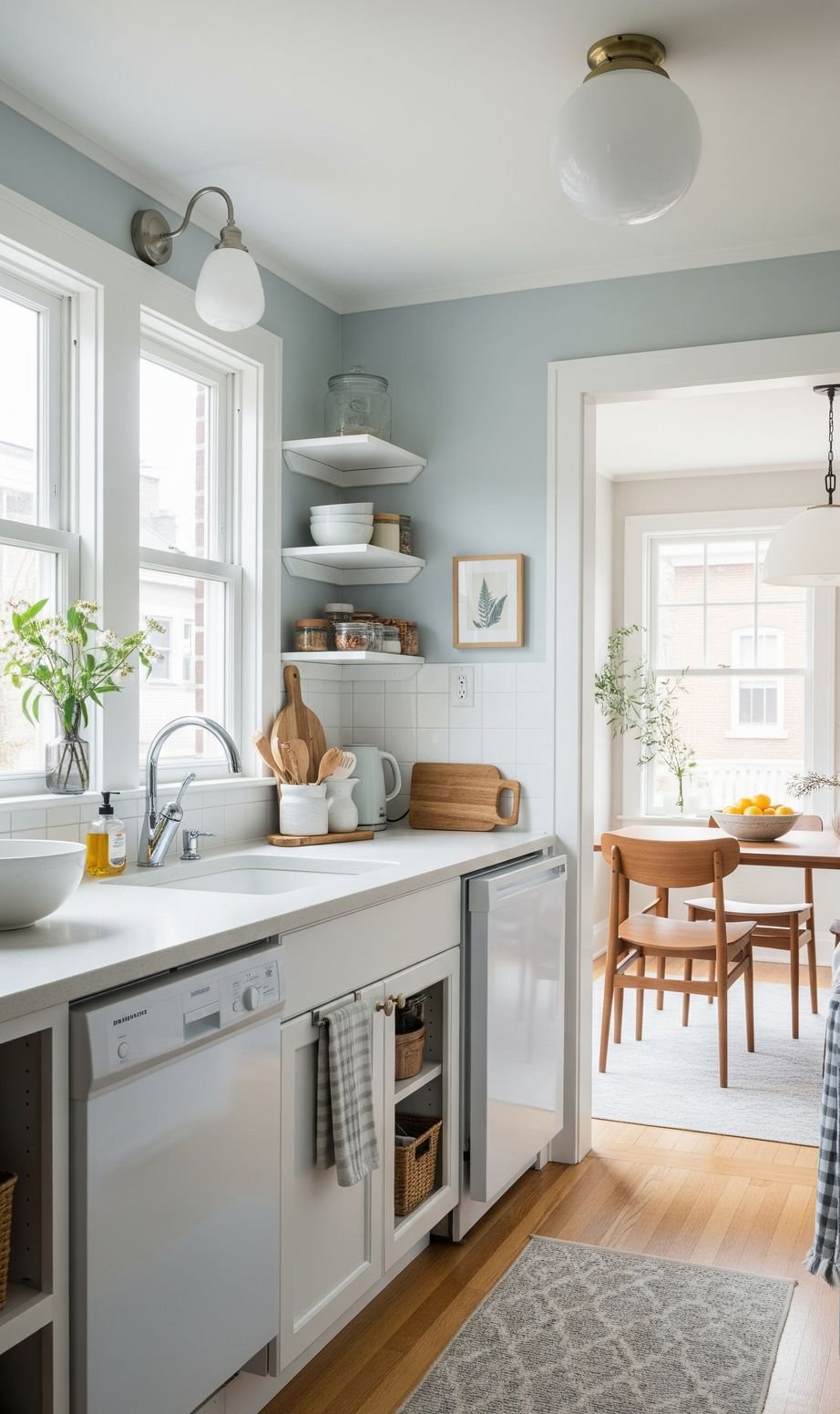How to Make a Small Kitchen Feel Airy
A small kitchen can often feel cramped and overwhelming. Limited counter space, insufficient storage, and a confined layout can make cooking and even simple tasks feel like a chore.
However, with careful planning and strategic design choices, it’s entirely possible to transform a small kitchen into a space that feels bright, open, and airy.
This article will explore various techniques and practical tips to maximize the sense of spaciousness in your small kitchen.
1. Embrace a Light and Bright Color Palette
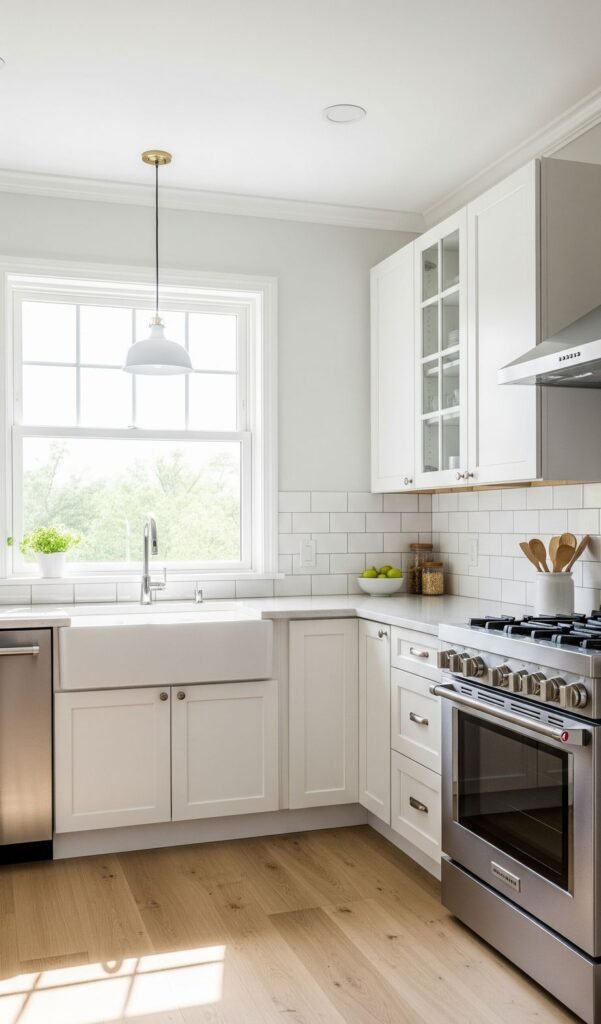
The colors you choose for your kitchen have a significant impact on how large or small it feels. Dark and heavy colors tend to absorb light and can make a small space feel even more enclosed.
Opting for a light and bright color palette is the first crucial step in creating an airy atmosphere.
- Walls: Choose light neutrals like white, off-white, cream, light gray, or very pale blues and greens. These colors reflect light, making the walls recede and the space feel larger. Consider using the same light color throughout the kitchen to create a seamless and continuous visual flow.
- Cabinets: Extend the light color scheme to your cabinetry. White or light-colored cabinets will contribute significantly to the feeling of openness. If you prefer a touch of color, consider light pastel shades or a soft, muted tone. For a more modern look, two-toned cabinets with lighter upper cabinets and slightly darker lower cabinets can add visual interest without overwhelming the space.
- Backsplash: Continue the light theme with your backsplash. Options like white subway tiles, light-colored natural stone, or even a mirrored backsplash can enhance the sense of light and space. A glossy finish will reflect even more light.
- Flooring: Light-colored flooring options, such as light wood, light-toned tiles, or light-colored vinyl, can also contribute to an airier feel. If you have dark flooring, consider using light-colored rugs in strategic areas.
2. Maximize Natural Light
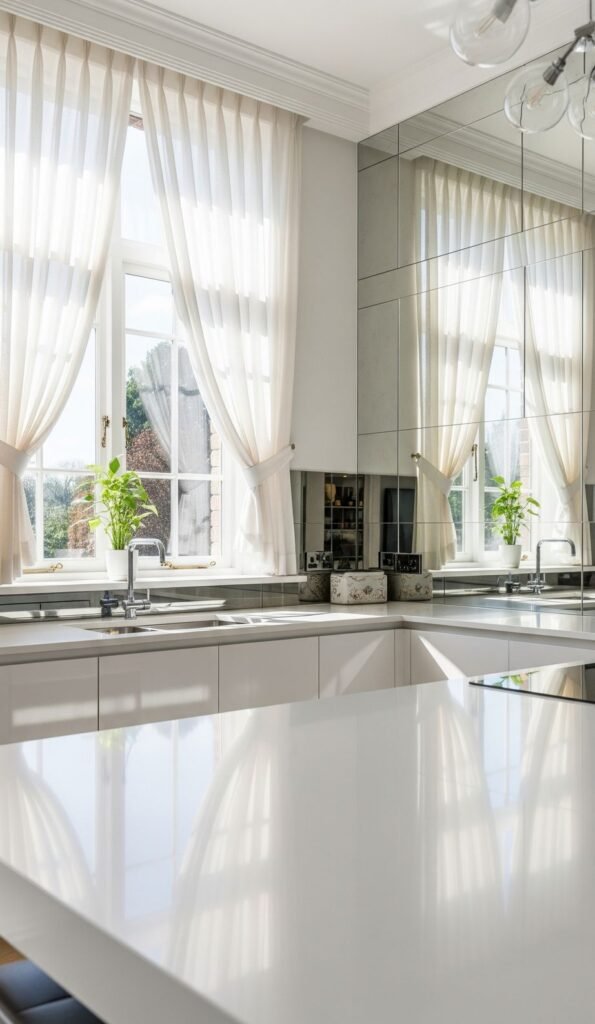
Natural light is a powerful tool for making any space feel larger and more inviting. In a small kitchen, maximizing the amount of natural light is essential.
- Window Treatments: Avoid heavy or dark curtains or blinds that block natural light. Opt for sheer or lightweight fabrics that allow light to filter through while still providing some privacy. Consider blinds or shades that can be fully retracted during the day to maximize the window opening.
- Window Size: If possible, consider increasing the size of your kitchen window or adding another window. This can dramatically transform the feeling of the space.
- Clean Windows: Ensure your windows are clean, both inside and out. Dirty windows can significantly reduce the amount of light that enters the kitchen.
- Light-Reflecting Surfaces: Incorporate elements that reflect natural light, such as glossy countertops, a mirrored backsplash, or even metallic accents. These surfaces will bounce light around the room, making it feel brighter and more spacious.
- Strategic Placement: Arrange your kitchen layout so that the main work areas, such as the sink and countertops, are positioned to take advantage of natural light.
3. Optimize Artificial Lighting
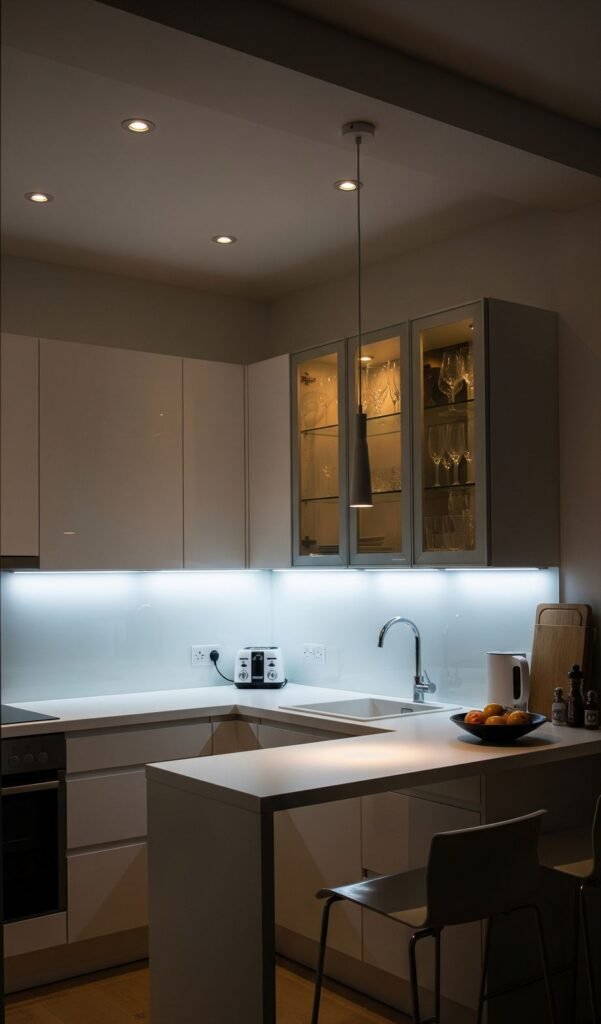
Even with ample natural light during the day, a well-designed artificial lighting scheme is crucial for making a small kitchen feel airy and functional at night. Layered lighting is key.
- Ambient Lighting: This provides overall illumination for the kitchen. Recessed spotlights or flush-mount fixtures are good options for small spaces as they don’t take up visual space. Consider dimmer switches to adjust the brightness and create different moods.
- Task Lighting: This focuses light on specific work areas. Under-cabinet lighting is essential for illuminating countertops, making food preparation easier and safer. Consider strip lights or individual puck lights. Pendant lights over a kitchen island or breakfast bar can also serve as task lighting and add a design element.
- Accent Lighting: This highlights specific features or adds visual interest. Consider spotlights to showcase open shelving or artwork. In-cabinet lighting can also create a sense of depth and highlight displayed items.
- Light Fixture Style: Choose light fixtures that are appropriately sized for your small kitchen. Avoid oversized or bulky fixtures that can overwhelm the space. Opt for sleek, minimalist designs.
- Bulb Temperature: Use daylight or cool white light bulbs, especially in work areas, as they tend to make a space feel brighter and more energetic. Warmer tones can be used for ambient and accent lighting to create a cozy atmosphere.
4. Declutter and Minimize Countertop Clutter
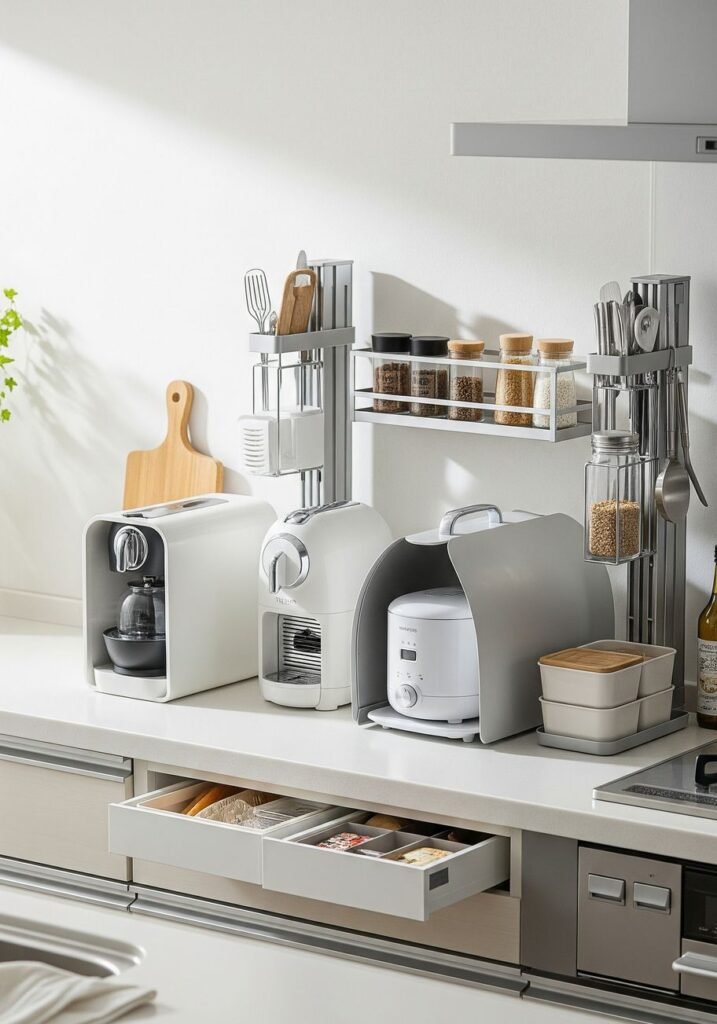
Cluttered countertops are a major contributor to a cramped and chaotic feeling in a small kitchen.
Regularly decluttering and finding smart storage solutions for your appliances and utensils is essential for creating an airy feel.
- Regular Purging: Go through your kitchen items regularly and get rid of anything you don’t use or need. This includes old gadgets, chipped dishes, and expired food.
- Vertical Storage: Utilize vertical space to keep items off the countertops. Install shelves, pot racks, and magnetic knife strips on walls to free up valuable counter space.
- Appliance Garages: Consider incorporating appliance garages into your cabinetry to hide small appliances like toasters, coffee makers, and blenders when they are not in use.
- Drawer Organizers: Use drawer dividers, inserts, and tiered organizers to keep drawers tidy and maximize storage capacity, preventing items from spilling onto the countertops.
- Multi-Functional Items: Opt for multi-functional appliances and tools to reduce the number of individual items cluttering your countertops and cabinets.
- Designated Spots: Assign a specific place for every item in your kitchen and make it a habit to put things back in their place immediately after use.
5. Optimize Storage Solutions
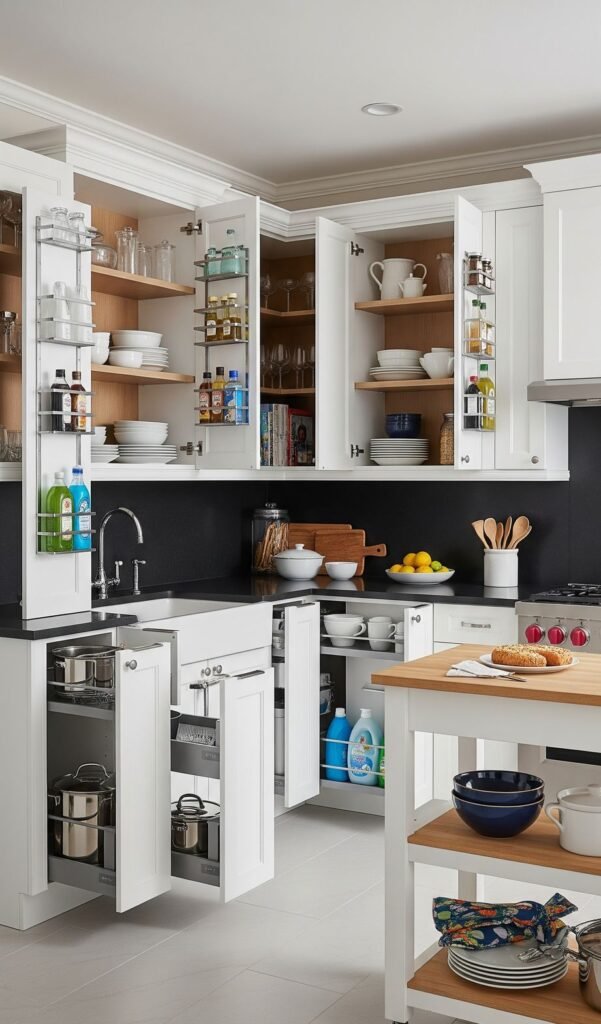
Smart and efficient storage solutions are paramount in a small kitchen. Maximizing every inch of available space will help keep clutter at bay and contribute to an airier feel.
- Tall Cabinets: If possible, install tall cabinets that reach the ceiling. This maximizes vertical storage space and visually elongates the walls, making the kitchen feel taller.
- Pull-Out Drawers and Shelves: Incorporate pull-out drawers and shelves in base cabinets for easy access to items stored at the back. This eliminates the need to rummage through deep cabinets and maximizes usable space.
- Corner Cabinet Solutions: Utilize lazy Susans or pull-out corner organizers to make the most of often-underutilized corner cabinets.
- Under-Sink Storage: Install organizers and caddies under the sink to keep cleaning supplies tidy and prevent clutter.
- Over-the-Door Organizers: Utilize the inside of cabinet doors for storing spices, lids, or other small items.
- Open Shelving: Consider incorporating some open shelving to display attractive dishes, glassware, or plants. However, be mindful not to overcrowd open shelves, as too much clutter can have the opposite effect.
- Consider a Kitchen Island or Cart: If space allows, a small kitchen island or a mobile kitchen cart can provide additional workspace and storage. Choose one with open shelving or drawers to maintain a sense of openness.
6. Choose Space-Saving Appliances and Fixtures
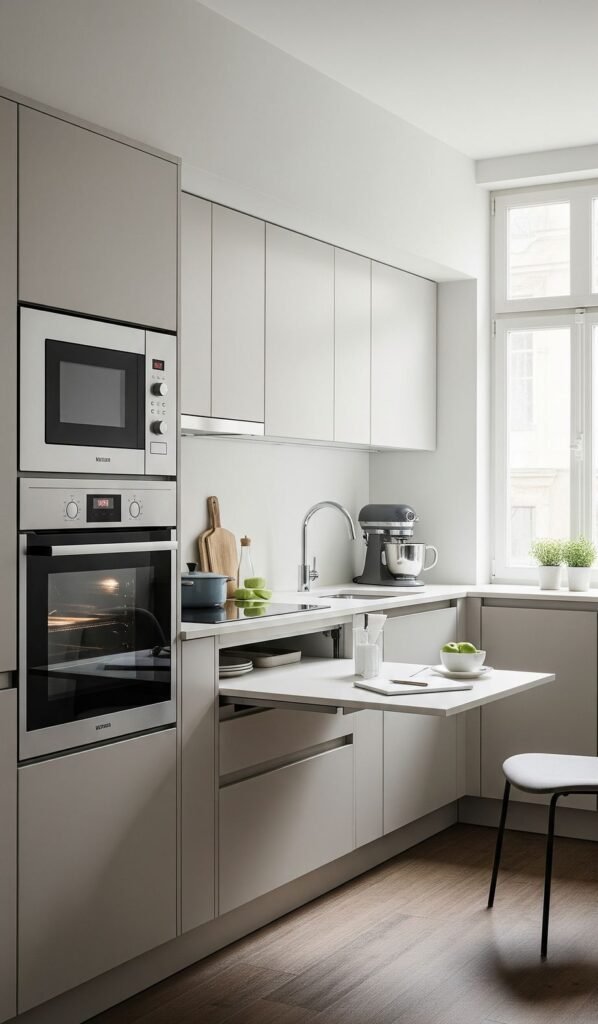
Selecting the right size and style of appliances and fixtures can make a significant difference in a small kitchen. Opting for space-saving options can free up valuable floor and counter space.
- Compact Appliances: Consider smaller versions of essential appliances, such as a slimline dishwasher, a smaller refrigerator, or a two-burner cooktop, if they meet your needs.
- Integrated Appliances: Choose integrated appliances that blend seamlessly with your cabinetry. This creates a cleaner and more streamlined look.
- Over-the-Range Microwave: Installing a microwave above the range frees up valuable countertop space.
- Wall-Mounted Ovens and Microwaves: If space is extremely limited, consider wall-mounted ovens and microwaves.
- Smaller Sink: A smaller single-basin sink can save countertop space compared to a large double-basin sink.
- Single Lever Faucets: These typically have a smaller footprint than traditional two-handle faucets.
- Fold-Down or Drop-Leaf Tables: If you have limited space for a dining area, consider a fold-down or drop-leaf table that can be stored away when not in use.
7. Create Visual Flow and Continuity
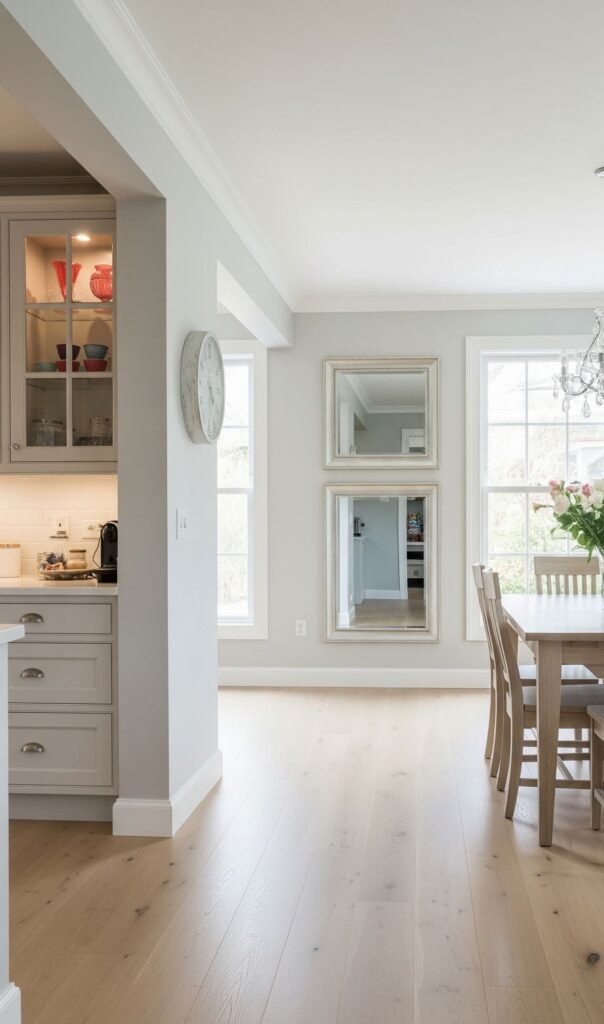
Maintaining a sense of visual flow and continuity can make a small kitchen feel larger and more connected to the rest of your home.
- Consistent Flooring: If your kitchen is open to another room, consider using the same flooring material throughout both spaces to create a seamless transition.
- Harmonious Color Palette: Extend the light and airy color palette from your kitchen into adjacent rooms to create a cohesive and flowing feel.
- Avoid Visual Barriers: If possible and structurally sound, consider removing non-load-bearing walls to open up the kitchen to a living or dining area. This creates a much more spacious and airy feel.
- Glass Cabinet Doors: Using glass inserts in some upper cabinet doors can create a sense of depth and visual interest, making the space feel more open.
- Mirrors: Strategically placed mirrors can visually expand the space and reflect light, making the kitchen feel larger and brighter.
8. Incorporate Natural Elements

Adding natural elements can bring a sense of freshness and airiness to a small kitchen.
- Plants and Herbs: Introduce small potted plants or herb gardens to bring life and a touch of nature into the kitchen. Greenery can create a feeling of freshness and vitality.
- Natural Materials: Incorporate natural materials like wood, bamboo, or woven baskets for storage and decor. These materials add warmth and texture without feeling heavy.
- Fresh Flowers: A simple vase of fresh flowers can instantly brighten up the space and add a touch of natural beauty.
- Good Ventilation: Ensure your kitchen has good ventilation, whether through a range hood or open windows. Fresh air can make a significant difference in how airy the space feels.
Conclusion
By implementing these strategies, you can effectively transform your small kitchen into a space that feels brighter, more open, and much more enjoyable to use.
Remember to prioritize functionality and choose design elements that work best for your individual needs and lifestyle.
